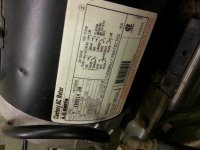The Dude
Hot Rolled
- Joined
- Oct 19, 2010
- Location
- Portland, OR
We are rebuilding a glass grinding machine which has a grinding spindle. Rebuilt, turns very smoothly, grinding wheel weighs maybe 5 lb. at the most. Spindle is belt-driven (v-belt) by a 120 VAC motor that sits on top. Motor is controlled by a relay. When starting, the motor shudders (I don't think there's anything wrong with the motor other than we maybe didn't select the correct type) enough to move the spindle carrier anywhere from .001-.004" (dove-tail slide, the ways are about 4" apart). The whole slide is fairly heavy duty but being driven by an amce thread (about 1/2") and it does have some backlash (from what I understand, that's normal and unavoidable). We can work around that as we typically will drive in from only one direction and "touch-off" each time we make a new part (very low production specialty parts for now). Also, I suspect we could tighten up on the way at the bottom (it's adjustable) but maybe only a thou or two.
Bottom line, is there an AC motor that's designed to start smoother that's economical and, if so, would it likely produce any benefit? We will have to do a "touch-off" and I'm thinking if we do it when the spindle is off, turn it on and then re-adjust after it moves I'd think we'd be good to go? The is all kind of "first-time" for me so I have really no idea what's normal.
Thanks,
The Dude


Bottom line, is there an AC motor that's designed to start smoother that's economical and, if so, would it likely produce any benefit? We will have to do a "touch-off" and I'm thinking if we do it when the spindle is off, turn it on and then re-adjust after it moves I'd think we'd be good to go? The is all kind of "first-time" for me so I have really no idea what's normal.
Thanks,
The Dude




